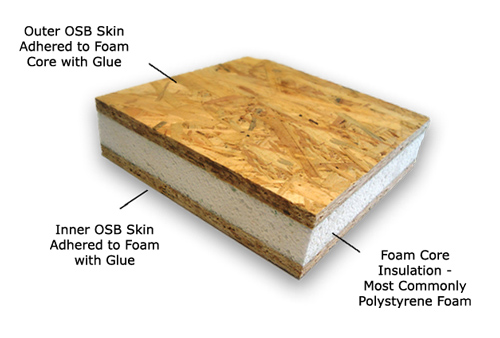Standard Framing Thickness:
2x4 (3 ½”) – R26
2x6 (5 ½”) – R42
2x8 (7 ¼”) – R52
Standard Widths:
4 feet wide
Standard Lengths:
Precuts: 92 5/8, 104 5/8, 116 5/8 inches
Full: 8, 9, 10, 12 feet
SIPs stands for Structural Insulated Panel (SIP). The product name is descriptive, being just that, an insulated panel that is structural. Used in the building industry for both residential and commercial construction, SIPs primarily are utilized for the exterior walls or roof of a structure. There are a variety of types of Structural Insulated Panels (SIPs) available on the market with many different features and in a wide range of costs. We will discuss some of the differences below, but let's start with a history lesson.
History of SIPs Panels
The concept of Structural Insulated Panels SIPs began in the 1930's, but Sandwich Panel structural insulated panels as we know them have been around since the 1950's. Seeking beautiful, but cost-effective homes, some of the earliest examples of SIPs homes were designed by Frank Lloyd Wright, although these structural insulated panels did not contain insulation. In the 50's an architecture student of Wright, Alden B. Dow, an environmentally conscious individual concerned about energy efficiency, designed a SIP panel with an insulated core. Many credit Dow to be the father of the structural insulated panel.
The most common structural insulated panel or SIP panel, Sandwich Panel SIPs, consist of a foam core insulation material, commonly polystyrene, sandwiched between two sheets of OSB and adhered with an adhesive or glue. The strength of the SIPs come from the combination of these materials. These sandwich panels are joined one to another with a spline and attached at the floor with a dimensional lumber bottom plate and supported at the top with top plates as in conventional framing.
History of RAY-CORE SIPs ®
A general contractor for over 50 years, Harry Raymond believed that the construction industry needed better ways to build more energy efficient, reducing a homeowner's heating and cooling costs for the lifetime of a home. Having worked with Sandwich Panel SIPs, he liked the benefits of solid foam insulation and the airtightness the panels provided, but he was also very familiar with the numerous problems associated with Sandwich Panel SIPs. Harry knew that there was a way to produce a more structurally reliable structural insulated panel. RAY-CORE's patented SIPs were the answer, manufacturing since 1987.
RAYCORE Structural Insulated Panels ® (SIPs) were to offer all the benefits of the more common Sandwich Panels SIPs and eliminate all the well known problems also associated with those SIPs by coupling the tried-and-true dependability and ease of conventional framing in a quick easy to use modular panel. RAY-CORE SIPs ® utilize conventional proven building materials: premium Douglas fir structural members, state-of-the-art rigid closed-cell polyurethane foam, and a foil radiant barrier. These superior building materials are combined, molded together into an easy to handle, lightweight structural insulating panel that meets or exceeds all local standard building codes.


* R means resistance to heat flow. The higher the R-value, the greater the insulation power. See RAYCORE SIPs Specification Sheet or Fact Sheet RAYCORE’s Technical Data Page.
Over 35 Years of Customer Satisfaction